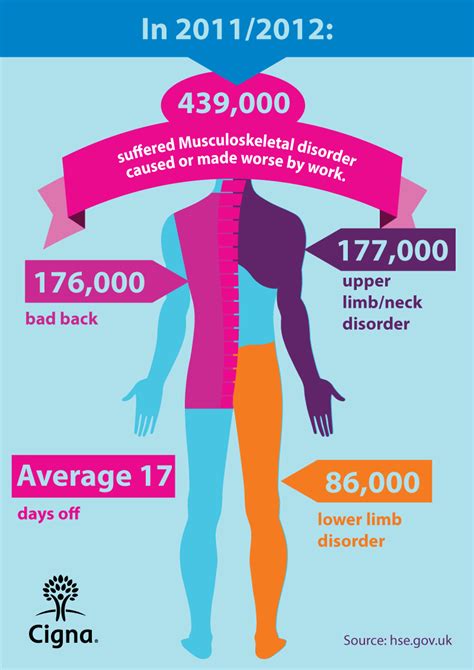Musculoskeletal Disorders Overview | Types, Symptoms, Treatment
Musculoskeletal Disorders FAQ
What are musculoskeletal disorders?
Musculoskeletal disorders are conditions that affect muscles, bones, joints, and connective tissue. They can be present at birth or develop as a result of injury or disease. Musculoskeletal disorders (MSDs) are conditions that can affect your muscles, bones, and joints. MSDs include: MSDs are common.
What causes musculoskeletal pain?
Muscle pain: Muscle spasms, cramps and injuries can all cause muscle pain. Some infections or tumors may also lead to muscle pain. Tendon and ligament pain: Ligaments and tendons are strong bands of tissue that connect your joints and bones. Sprains, strains and overuse injuries can lead to tendon or ligament pain.
What are musculoskeletal disorders (MSDs)?
Musculoskeletal disorders (MSDs) are conditions that can affect your muscles, bones, and joints. MSDs include: MSDs are common. And your risk of developing them increases with age. The severity of MSDs can vary. In some cases, they cause pain and discomfort that interferes with everyday activities.
What is musculoskeletal pain?
Musculoskeletal pain is pain that affects: Bones. Joints. Ligaments. Muscles. Tendons. Musculoskeletal pain can be acute, meaning it is sudden and severe. Or the pain can be chronic (long-lasting). You may have localized pain (in one area of your body), or it may affect your entire body. Cleveland Clinic is a non-profit academic medical center.
What are musculoskeletal (MSK) conditions?
Musculoskeletal (MSK) conditions affect many people and can affect your joints, bones and muscles and sometimes associated tissues such as your nerves. They can range from minor injuries to long-term conditions. Over 20 million people in the UK, almost one third of the population, have a MSK condition such as arthritis or back pain.
What is musculoskeletal health?
WHO is responding to the burden attributed to musculoskeletal conditions across a number of programmatic areas. Musculoskeletal health refers to the performance of the locomotor system, comprising intact muscles, bones, joints and adjacent connective tissues.
How do musculoskeletal disorders affect the body?
Musculoskeletal disorders (MSDs) affect the muscles, bones, and joints. Your risk of developing one increases with age. But by taking care of your body, you can lower your risk. We’ll describe the causes and symptoms of MSDs, and what healthy lifestyle habits to adopt that may help prevent them.
Musculoskeletal Disorders References
If you want to know more about Musculoskeletal Disorders, consider exploring links below:
What Is Musculoskeletal Disorders
- https://www.healthline.com/health/musculoskeletal-disorders
- https://www.medicalnewstoday.com/articles/musculoskeletal-disorders
- https://www.who.int/news-room/fact-sheets/detail/musculoskeletal-conditions
- https://my.clevelandclinic.org/health/diseases/14526-musculoskeletal-pain
- https://www.england.nhs.uk/elective-care-transformation/best-practice-solutions/musculoskeletal/
- https://en.wikipedia.org/wiki/Musculoskeletal_disorder
- https://www.merckmanuals.com/home/bone,-joint,-and-muscle-disorders/symptoms-of-musculoskeletal-disorders/musculoskeletal-pain
- https://www.ncbi.nlm.nih.gov/books/NBK559512/
- https://www.msdmanuals.com/home/bone,-joint,-and-muscle-disorders/symptoms-of-musculoskeletal-disorders/introduction-to-symptoms-of-musculoskeletal-disorders
- https://www.niams.nih.gov/health-topics/muscle-bone-diseases
Musculoskeletal Disorders Information
Explore Related Topics
Unlocking the Potential of Chiropractic Care for Diabetic Neuropathy
Unlock the potential benefits of chiropractic care in addressing diabetic neuropathy concerns.
